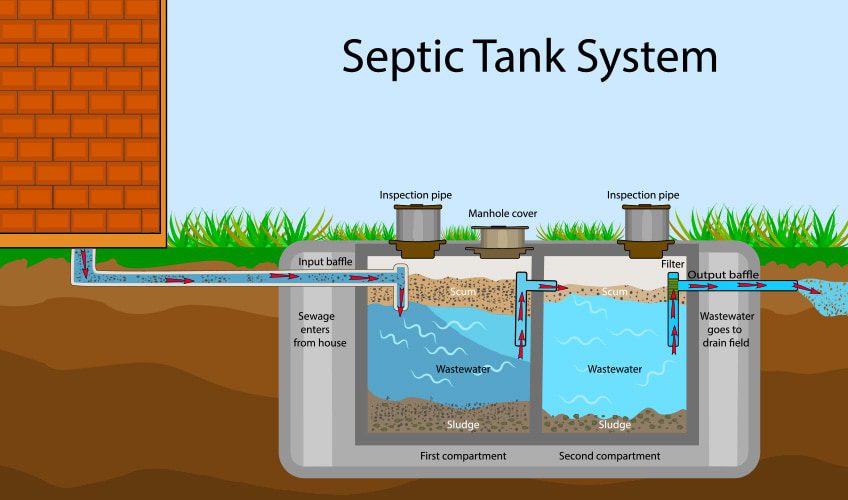Septic Tank Pumping
Septic tank 101
Even the healthiest septic systems need to be cleaned every one to three years. Skip the routine cleaning and you might wake up one day to find raw sewage backing up your toilets and drains. At that point, the solution is not simple, pleasant, or inexpensive.
Waste in a septic system breaks down into three layers – solid material called sludge on the bottom, oils and fats called scum in the middle and a clear liquid known as effluent or gray water on top. Effluent is discharged into the leach field, but the sludge and scum accumulate in the tank and need to be removed from time to time.
To prevent septic failure, sludge and scum need to be pumped out when the scum layer is within 6 inches of the outlet pipe or the top of the sludge layer is within 12 inches, according to the U.S. Environmental Protection Agency.
What is a Septic Tank?
A septic tank is an underground storage tank for sewage waste for homes that don’t have access to city sewer systems. They vary in size and composition, but their purpose is the same: to hold sewage and provide basic sanitation and wastewater treatment until the tank requires emptying by a company that offers septic tank pumping.
A septic tank typically holds waste long enough for solids to separate from the liquid and discharges that wastewater to a drainage field (called a leach field) or soil absorption field. That effluent water contains organic wastewater that will be discharged into the soil and fertilize it. An example of how a septic system works is illustrated below.



Cost to Pump Out a Septic Tank
The cost depends on the size of the tank and how full it is. Also, rates vary from one contractor to another and from one geographic location to another. Call 317-858-8066 with your septic specifics so we can assess what you could expect to pay for the proper services.
A little bit of preventative maintenance saves a lot of money in the long run. The cost to replace a failing septic system is usually about $3,000 to $10,000 – or more. Properly maintained, however, a septic system can last 20 to 40 years.



When To Have Your Tank Cleaned
Annual inspections are key to monitoring your sludge and scum levels. Otherwise, it can be difficult to know when they’re high. A measure the levels, check your system’s pipes and make sure the drain field is working properly. If scum and sludge levels are high, the service will recommend a cleaning.
Without regular cleanings, your system can overflow, causing significant damage and potentially leading to the problems mentioned above.
The frequency of required cleanings depends on the size of your tank, the number of people in the home and your usage habits. As a very general rule, if there are only one or two people in the home, septic tank cleaning is only necessary every five years. With three to five people, plan on every two or three years. More than five people and you might be looking at once a year, particularly if the tank is small. Keep in mind that use of a garbage disposal and appliances that require lots of water, such as hot tubs, will increase the frequency of required pumping.
Besides an inspection, there are a couple other indicators that your septic needs cleaning. Some systems have an alarm system that flashes a light or sounds a siren when the tank is full. The smell of raw sewage in your yard is a strong indicator, too.
Call Our office for a Free Septic Tank Pumping Quote @ 317-858-8066.
The Inspection Process
The first step in our inspection process is locating your septic system, which is not always easy. If you have previous inspection records that show the tank’s location, please provide those to the Septic Technician. If not, save the records from this inspection to save time and money on the next one.
Once the septic tank has been located, the service will uncover the manhole and inspection port, which sometimes requires digging. If so, consider having an access cover (Riser Lid) installed which we can provide and install to make future inspections easier and less expensive.
Next, the septic technician will test your system by running water and flushing toilets to make sure waste is properly flowing to the system. Then the Technician will measure the sludge and scum using specialized tools that are inserted into the inspection port. The inspection also includes tasks such as checking the tank for cracks and examining the leach field for signs of failure.
If the tank only needs to be pumped, our technician will transport the waste to the local treatment plant.
What to expect when the Inspection Report is completed?
We will provide a detailed pricing structure for all services you’re needing. We will also provide you with our Company’s liability and Worker’s compensation Insurance Certificate.
How to Protect Your Septic System
Regular inspections are a must, but there are many things you can do to prolong the life of your septic system and reduce the frequency of pumping:
- Watch what you put down the drain. Never wash down food scraps, grease, or oil. If you have a garbage disposal, consider using it sparingly. Composting or throwing away food scraps instead will extend the time between pumping’s.
- Never flush anything besides toilet paper. This includes tissues, tampons, sanitary napkins, and paper towels.
- Stick to cleaning products that are approved for septic systems. Use products like toilet cleaners, drain cleaners and bleach in moderation. They can damage your septic system, particularly with frequent use.
- Avoid products that claim to clean your septic system. Most professionals agree these products are ineffective and potentially harmful to the system.
- Never plant shrubs or flowers over your leach field, and never let anyone drive or park a vehicle on top of it.
Septic Tank Pumping Schedule
Following a septic tank pumping schedule is a good idea.
Many homeowners like yourself ask us this question . . .How often should I pump my septic tank?
To help you out, see the following schedule obtained from the US EPA. The frequency of septic tank pumping is based on the size of the septic tank and the number of occupants in the household.
This guide to septic tank cleaning or pumping is intended to assist you in scheduling your septic tank maintenance.
Septic tank cleaning and pumping is a critical step in septic system care as it extends the life of the septic field. Even if you don’t care how septic systems work you need to know how often to pump your septic tank.
In the table below you can look up your tank size and number of persons in the household to see how often the septic tank should be cleaned.
For example, a 1,000-gallon septic tank, which is used by two people, should be pumped every 5.9 years.
If there are eight people using a 1,000-gallon septic tank, it should be pumped every year.
Septic Tank Pumping Table



Remember this is a recommended schedule based on the average daily flow of wastewater leaving your house. Some households use a lot more water than others. They simply do more laundry, take more showers, or cook more meals than other households.
All of these activities generate more wastewater and more solid waste that will need to be removed from your septic tank.
You may need to pump your septic tank more frequently.
It is also a good idea to pump the septic tank just before a party or large gathering of people. The large flow of wastewater into the septic tank can temporarily overload the septic tank and septic system. This could cause a stoppage in the sewer line between the house and the septic tank.
We recommend that you establish and maintain a septic tank pumping schedule just like scheduled oil changes on your car. Regular septic maintenance is key to a long-lasting septic system.
The Bottom Line
Your septic tank is an investment in sustainable and affordable sewage treatment when you don’t have access to city sewer systems. Taking care of it with regular maintenance and service will keep your home functioning like it’s supposed to, and you’ll avoid the woes and headaches of homeowners who neglect care because it is “out of sight and mind.”
With a little time, some homework, and taking the right steps, you can be confident your septic tank system is working as efficiently as it can for years to come.



